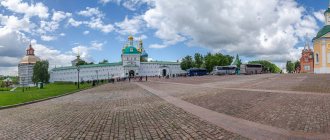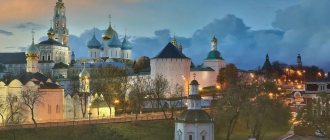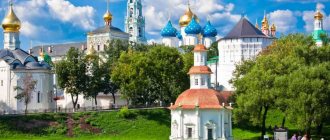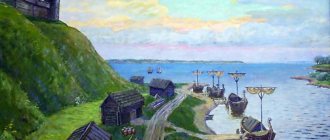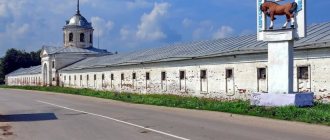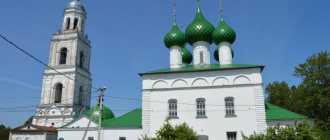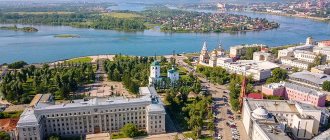General information
The city near Moscow has become a point of attraction for pilgrims. The amazing history of Sergiev Posad has opened up enormous opportunities for the development of the tourism sector.
The city is located 70 kilometers from the capital. About 100 thousand inhabitants live here. Sergiev Posad captivates travelers with its peaceful atmosphere. Here you can gain strength, cheer up, and make the right decision.
Here is the pearl of Russian Orthodoxy - the Holy Trinity Lavra of St. Sergius complex. But even if you bypass the monastery, there are many other, no less interesting attractions.
Every Russian should visit here at least once and touch the secret that these holy lands keep.
History of the city of Sergiev Posad
The city is named after the saint known as Sergius of Radonezh. He founded a monastery. The date of creation of the monastery is said to be 1345. The shrine became famous throughout Rus'. Dmitry Donskoy came here for a blessing before the great Battle of Kulikovo.
Over time, a settlement began to form around the monastery. The following points are considered important dates in the history of the existence of Sergiev Posad:
- 1408 The first monastery was burned by Mongol-Tatar nomads who captured Rus'.
- 1411 A new monastery was built. From that time on, the appearance of the city began to take shape. Slobodas arose. Already at that time there were such settlements as Pushkarskaya, Ikonnaya and others.
- 1422 The first stone temple was erected. Later, the founder, Sergei of Radonezh, was buried within its walls. The monastery continued its existence in subsequent centuries, receiving new novices and noble guests who came for blessings.
- 1744 The monastery gained importance. He was given the status of Lavra.
- 1782 The independent history of the city of Sergiev Posad begins. Residents were engaged in trade and served pilgrims who flocked to the monastery in large numbers.
- 1814 The first theological academy opened in the city. The number of clergy increased during these years. The bulk of the population were people close to the church.
- 1920 The monastery has been converted into a museum. It still matters to people. But the Soviet government condemns religious views.
- 1930 The city is named Zagorsk. In this way, the authorities are trying to reduce citizens’ interest in the shrine.
- 1991 The settlement is returned to its former name. The monastery is being revived. People all over the world are once again interested in holy places.
Today Sergiev Posad is a significant place for pilgrims. There are over 250 historical and cultural monuments located in the city. The tourism infrastructure is actively developing.
It is better to come here for 2-3 days. Then you will be able to get acquainted with all the significant sights. Mostly pilgrims and those interested in religious architectural monuments come here.
Map of Sergiev Posad with houses
Modern residential areas are located near the historical center of the city. The most prestigious are:
- Archimedes;
- Grand Park;
- Uglich;
- Klementyevsky;
- Posad-Premier.
These are beautiful residential complexes with developed infrastructure, good roads and high-rise buildings, which can be seen on the map of Sergiev Posad with house numbers.
For tourists, the city center with its main attraction is more attractive. People come here from all over the country and other states who want to touch the holy relics of Sergius of Radonezh. Here are the burial places of representatives of the Godunov family, handwritten chronicles, as well as treasures in the form of royal offerings to the monastery.
In addition to the Lavra, local residents recommend visiting other attractions, the location of which can be found on a detailed map of Sergiev Posad. Among the memorable places:
- Vvedenskaya Church;
- Horse yard;
- Pyatnitskoye Compound;
- Toy Museum;
- Soviet square;
- Gremyachiy Klyuch waterfall;
- City fountain;
- Monument to Peter and Fevronia.
The historical monuments of Sergiev Posad reach 500 years old; in one city you can see a variety of architectural styles and plunge into different periods of Russian history.
Sights of Sergiev Posad
The main attraction, the pearl of the city, is the Trinity Lavra of St. Sergius. Thanks to her, Sergiev Posad was formed. Trinity-Sergius Lavra is an architectural ensemble consisting of temples, churches, cathedrals.
The Trinity Cathedral is noteworthy. This is a 15th century monument. Within its walls is an iconostasis, on which Andrei Rublev, a famous Russian icon painter, worked.
Visitors examine the Holy Spiritual Church, a 5-tier bell tower, the Temple of Sergius of Radonezh and other objects located on the territory of the complex.
According to legend, two monks came here in the 14th century: Bartholomew and Stephen. They founded a monastery, which marked the beginning of the Trinity-Sergius Lavra.
The Assumption Cathedral also deserves attention. This is a monument from the mid-16th century. In general, the Trinity-Sergius Lavra is located in the very center of the city. It is impossible to pass by her. It serves as a monastery.
Buildings from the 16th, 17th, 18th, 19th and 20th centuries have been preserved on the territory of the complex. About 200 monks live within the walls of the monastery.
Excursions are organized for visitors every day. The accompanying person introduces you to the iconic sights and life of the monks.
In addition to the Trinity-Sergius Lavra, there are other attractions in the city that deserve special attention. First of all, these are the Pyatnitsky well, the monument to Sergei of Radonezh and museum institutions.
Visit the Skitskie Prudy park. In summer there is a skate zone, children's playgrounds and carousels.
If you want to admire the Trinity-Sergius Lavra from above, go to Pancake Mountain. From here you can see the immediate surroundings. The hill received its name at the end of the 19th century. Pancakes were baked here, which were enjoyed not only by visiting pilgrims, but also by local residents.
If time permits, explore the following attractions:
- Park of Wonders:
- Husky House;
- Museum of the Moscow Theological Academy;
- Monument to “Victims of the Years of Persecution and Repression”;
- Source of St. Savva of Storozhevsky.
Sergiev Posad is full of attractions. It is impossible to study it completely even in a few days. Picturesque views and a peaceful environment encourage leisurely walks and exploring interesting sites.
Chernigov men's monastery of the Trinity-Sergius Lavra
Chernigov men's monastery of the Trinity-Sergius Lavra in Sergius...
Moscow region
In the 40s of the 19th century, three kilometers from the Trinity-Sergius Lavra, the Monk Anthony founded the Gethsemane Chernigov monastery - a separate monastery for hermit monks. The secluded picturesque place became a haven for more than 400 monks. Anthony commanded that the monastery be kept in simplicity and austerity - even the church utensils were made of wood. Saint Philaret of Moscow wrote: “Simplicity... is the hope of the monastery. May the Lord preserve this." After the revolution, the monastery was closed, and monastic life here resumed only in the 90s of the 20th century.
The Chernigov monastery is named after the miraculous Chernigov Icon of the Mother of God, brought to the monastery at the end of the 19th century, and the Gethsemane monastery is named after the Garden of Jerusalem, where the Mother of God is buried. To this day, the monastery has preserved cave temples, monastic cells, a holy spring and ancient monastery buildings.
City museums
If you visit Sergiev Posad on your own, don't miss out on the unusual Toy Museum. Its exhibition includes more than 150 thousand of a wide variety of items created by craftsmen for the enjoyment of children. There are toys from both foreign and domestic masters. Sergiev Posad is even known in the world as the “Capital of the Kingdom of Toys”. Therefore, you can take children on the trip too. They won't be bored.
Legend has it that toys were made on the territory of the Trinity-Sergius Lavra 200 years ago. Local residents sold them to pilgrims who arrived to visit the monastery.
Be sure to check out the Museum of Soviet Childhood. Here are collected toys and board games that replaced gadgets for children in the last century. Adults speak highly of the visit. They claim that it is as if they were momentarily transported back to their childhood.
Visit the Sergiev Posad Museum-Reserve. It was founded 100 years ago, and its fund includes over 100 thousand storage units. There are icons, silver utensils, religious objects, and paintings by famous painters.
The Horse Yard is popular. This is also a museum. Previously, the building housed a stable. Now there are several regular exhibitions within the walls of the Horse Yard. One of them is dedicated to the Russian nesting doll. Other exhibitions tell about life in the Russian village and about applied art. Real masterpieces created by the hands of folk craftsmen are exhibited here.
The Museum of Peasant Life "Once Upon a Time" belongs to V. Bagrov. A local artist has put together a unique collection. You can admire homespun clothes made in the last century, clay and wooden household items, kitchen utensils, and a collection of semi-precious stones.
In the house of Pavel Florensky, who is called the Russian Leonardo de Vinci, the furnishings that existed during the life of the priest, scientist, and painter have been preserved. There is a piano here. The brilliant inventor made it with his own hands. He was shot by the Bolsheviks. You can walk around Sergiev Posad all day and discover more and more new sights. We have listed only the most popular among tourists, but the list of religious monuments, museums, and exhibitions does not end there.
What to see in the vicinity of Sergiev Posad
15 km from Sergiev Posad there is an amazing open-air ethnic park “Nomad”. Here are the dwellings of nomadic tribes. You will be able to get acquainted with the life, culture and traditions of different nationalities. In addition, you will see exotic animals: deer, northern dogs, Kalmyk camels, yaks and other representatives of northern latitudes.
The Abramtsevo estate also deserves attention. This is a kind of museum-reserve. S. Aksakov once lived here, and later Savva Mamontov began to own the estate. No less famous guests came to the estate to visit the famous owners. The estate is located 20 kilometers from the city.
Guests of Sergiev Posad certainly go to Gremyachiy Klyuch. This source, as local legend says, was begged by Sergius of Radonezh. Its waters are considered healing. People come here to ask the Almighty for health. The territory is landscaped. The attraction is located 28 km from the city.
The Muranovo Estate Museum is 30 km from Sergiev Posad. At one time, people who belonged to the sphere of writers lived here; F. Tyutchev was among the owners. The main exhibitions are dedicated to him. The idea of creating such an institution belongs to the leader of the Soviet people - V. Lenin.
And the village of Vasilyevo will appeal to fans of folklore. 40 kilometers from the city is the Museum of Slavic Fairy Tales and Mythology. Young travelers really like the interactive complex.
In Khotkovo (15 km) there is an interesting institution - the Raccoon House. Here you can observe the life and habits of the animals, feed them and take memorable photographs.
State Historical, Artistic and Literary Museum-Reserve "Abramtsevo"
Historical, artistic and literary museum-reserve…
Sergiev Posad district
On the banks of the Vori River, not far from Sergiev Posad, the Abramtsevo Museum-Reserve is located. In the middle of the 18th century, a manor appeared here, which became a source of inspiration for famous writers and artists. In 1843, the writer Sergei Aksakov acquired the estate; writers Nikolai Gogol and Ivan Turgenev, actor Mikhail Shchepkin, and historian Mikhail Pogodin liked to stay with him. In 1870, the house was bought by philanthropist Savva Mamontov - then the Abramtsevo art circle was formed here, which included artists Konstantin Korovin, Ilya Repin, Valentin Serov, Vasily Polenov, Viktor Vasnetsov and others.
After the revolution, a museum was opened in the estate, but the traditions of the Mamontov circle did not stop - in the 20th century, artists Pyotr Konchalovsky, Igor Grabar, Ilya Mashkov, sculptors Boris Korolev and Vera Mukhina worked in Abramtsevo. Today, the collection of the Abramtsevo Museum contains more than 25 thousand exhibits - photo archives and personal belongings of the former owners of the estate, graphics, paintings, sculptures and works of folk art.
Interesting Facts
There are interesting facts associated with the city. In general, this area is rich in stories and legends. You can get complete information about them on the excursion. We definitely recommend using the services of guides and then exploring the city and its surroundings on your own.
So, let's present the 10 most interesting facts:
- Sergiev Posad is included in the list of the most ancient cities of the Russian Federation.
- The area of the city is 50x50 sq. kilometers. It is twice the size of the Pacific country of Tuvalu.
- This is the only city of the Golden Ring located in the Moscow region.
- The Trinity-Sergius Lavra includes more than fifty architectural objects, and the entire complex is protected by UNESCO.
- It is believed that Sergiev Posad is the birthplace of the Russian nesting doll.
- At one time, N. Gogol, L. Tolstoy, A. Akhmatova, Yu. M. Lermontov came here.
- Ivan the Terrible was baptized in a local church.
- More than 300 thousand pilgrims come to Sergiev Posad every year. At the same time, the Chinese make up more than half of the tourists.
- There are only two laurels in Russia. One of them is located in St. Petersburg.
- The Trinity-Sergius Lavra houses the largest bell on the planet. Its weight is 72 tons.
You will learn even more interesting facts when visiting the city.
Historical reference
Sergiev Posad is a city (since 1782) in the Moscow region of Russia, the administrative center of the Sergiev Posad district of the Moscow region, the largest settlement of the municipal formation "Urban Settlement Sergiev Posad", is the center of the Sergiev Posad urban agglomeration, with a population of over 220 thousand people ( year 2014).
Sergiev Posad was named after St. Sergius, who founded the largest monastery in Russia.
In 1919 the city was renamed Sergiev, and in 1930. - to Zagorsk, in honor of the revolutionary V. M. Zagorsky. But in 1991 the city was returned to its historical name. The city was founded by the Trinity Monastery. The glory of St. Sergius and the monastery he founded attracted pilgrims to the monastery. Gradually, peasants began to settle near the monastery. They practiced animal husbandry: rabbits, geese, chickens, as well as pigs and cows. The first settlements that became the basis for the future city were the villages of Kokuevo, Panino and Klementyevo.
Trinity Monastery has always been a large landowner. The lands belonging to the monastery had large state benefits, which contributed to the development of trade and crafts. In the area around the monastery, settlements of artisans were gradually created. This is how the Icon and Povarskaya, Konyushennaya and Cart, Pushkarskaya and Streletskaya settlements appeared.
Sergiev Posad. The economic life of the city also depended on the needs of the monastery. Due to the great demand among pilgrims for religious objects, the production of crosses, candlesticks, icons, etc. was developed here.
But the Sergiev toy gained the greatest popularity. No wonder Sergiev Posad was called “the capital of the amusing kingdom.” Buying a toy near the walls of the Lavra means doing a godly deed. After all, St. Sergius himself cut toys for the amusement of the children. The monastery did not lag behind local industrialists.
In the 19th century, the monks developed extensive economic activities: they created their own enterprises - a brick factory, paper mills, and a printing house. These establishments were rented out or maintained by hired workers.
Currently, Sergiev Posad is the largest administrative, industrial, cultural and tourist center of the Moscow region, the pearl of the “Golden Ring”. The city's convenient location on transport arteries connecting Russian regions with Moscow, excellent road and rail connections contribute to the development of the city and region.
Trinity-Sergius Lavra. Film by Svetlana Rutskaya.
The Trinity-Sergius Lavra, in church literature usually the Holy Trinity Sergius Lavra, is the largest Orthodox male stauropegic monastery in Russia (ROC), located in the center of the city of Sergiev Posad, Moscow region, on the Konchura River.
Founded in 1337 by St. Sergius of Radonezh. The Trinity-Sergius Monastery stands on the low Makovtse hill, at the confluence of the Konchura and Vondyuga rivers. The monastery was founded in the 30s-40s of the 14th century by the brothers Bartholomew and Stephen. Bartholomew, who took monastic orders with the name Sergius, went down in history not only as the founder of the monastery, but also as an active supporter of the Moscow princes, advocating the unification of Russian lands around Moscow. It was he who blessed Prince Dmitry Donskoy before the Battle of Kulikovo. In 1355, for the first time in north-eastern Rus', a communal charter was introduced at the Trinity Monastery, which caused the restructuring of the entire monastery. The monastery began to resemble a small wooden town, consisting of three parts: public, residential and defensive. Behind a strong fence is a rectangle of cells, inside of which there is a church and a refectory. It is curious that the monastery carried this layout through all subsequent centuries and preserved it to this day.
St. Sergius died in 1392. In 1422, the canonization of St. Sergius took place and the laying of the white stone Trinity Cathedral over his grave took place.
Ivan the Terrible was baptized in the monastery, during whose reign great importance was attached to transforming the monastery into a powerful fortress, which was important on the approaches to Moscow. Instead of a wooden fence in 1540-1550. a powerful wall with towers made of brick and stone was built. In 1608-1610. The monastery was under siege by Polish-Lithuanian invaders for sixteen months. The feat of the monastery’s defenders became widely known and contributed to the growth of the monastery’s authority.
Under Peter I, the monastery still retained its significance as a royal fortress. In 1689, during the Streltsy riot in Moscow, Tsar Peter took refuge behind the walls of the monastery. In 1744, by decree of Empress Elizabeth Petrovna, the monastery was awarded the honorary title of Lavra, which emphasized the leading role of the monastery among other church institutions.
From 1919 to 1946 the monastery was closed. The temples were removed from the monastery, the monks were dispersed or repressed. Today the Lavra is a functioning monastery, the spiritual center of Orthodox Russia. On the territory of the monastery there are the Moscow Theological Academy and Seminary, as well as a museum-reserve. All of them, in their own way, serve to preserve the spiritual traditions, history and monuments of this amazing place, where the soul of Russia lives on. Numerous Lavra structures, erected during the 15th-19th centuries by the best masters of Russia, represent a kind of manual on the history of Russian architecture, an open-air museum. The architectural ensemble of the Trinity-Sergius Lavra is included in the UNESCO World Heritage List.
The most ancient churches of Sergiev Posad are located on the south-eastern side of the Trinity-Sergius Lavra, at the foot of the hill, “on Podol” - the Church of the Entry into the Temple of the Blessed Virgin Mary and the Church of the Martyr Paraskeva Pyatnitsa. In 1547, on the site of the wooden parish church of the Servants of the Sloboda, two stone churches were built at once. The Vvedenskaya Church was built at the expense of the boyar I. Khabarov, the construction of the Pyatnitskaya Church was financed by the Trinity Monastery. The Art Pedagogical Museum of Toys was founded in 1918. In Sergiev Posad there is a research institute for toys and the only toy college in the country. Together with the toy museum, this unusual complex preserves the city’s reputation as the “capital of the amusing kingdom.” It was here that the world-famous Russian nesting doll was born.
The museum's exhibitions trace the history of Russian toys; there is an opportunity to take an excursion into the field of children's culture in many foreign countries.
Eleven kilometers separate Sergiev Posad from the city of Khotkovo, located on the Pazhe River. The main chronicle of the city began with the appearance here in 1308 of the oldest Pokrovsky Khotkov monastery in the Moscow region.
According to the Life of St. Sergius of Radonezh, the St. Stephen’s brother took monastic vows here, and their parents, the Rostov boyars Kirill and Maria, were buried here.
Initially existing as a monastery of a mixed type for both men and women to live here, in 1544 the Intercession Monastery was transferred under the control of the Trinity-Sergius Monastery by royal charter and turned into a nunnery. By one of the decrees of Peter I, masters of lace and gold embroidery from Holland were invited to the monastery, who taught the nuns these arts. Therefore, all pilgrims going to Trinity tried to purchase lace or a skillfully embroidered scarf.
Now the monastery consists of buildings from the 18th-19th centuries. The main ones are the Intercession Cathedral (1811-1816) and St. Nicholas Church (1899-1904).
The settlement of Radonezh arose on the Pazhe River around the 11th century. The name of St. Sergius of Radonezh, who, as a youth, lived in Radonezh with his parents, is associated with Radonezh. The first Prince of Radonezh was Andrei Vladimirovich, the son of the famous associate of Dmitry Donskoy in the Battle of Kulikovo, Vladimir the Brave. Under Andrei Vladimirovich, Radonezh became the capital of a small appanage principality that defended Moscow from the north. By this time, Radonezh is turning from a village into a city.
During the events of the “Time of Troubles,” Radonezh became deserted. By royal decree, it was granted in 1616 to the Trinity Monastery, which resettled peasants from their other estates to the territory of Radonezh. A settlement called Gorodok was revived. Next to the Transfiguration Church (1836-1842), built at the expense of parishioners, a monument to St. Sergius was erected in 1988. At the foot lies a stone with the inscription “Grateful Russia to Sergius of Radonezh.” In 1989, the ancient name Radonezh was returned to the village of Gorodok.
What to bring from Sergiev Posad as a gift
There are souvenir shops around the Trinity-Sergius Lavra. Here is the largest selection. Can buy:
- colorful headscarves;
- icons and religious literature;
- designer products (boxes, bracelets, egg coasters, etc.);
- religious paraphernalia (crosses, icons, chains, rings with the inscription “God bless me”).
In addition, in Sergiev Posad you will certainly come across shops with wooden toys: nesting dolls, whistles, animal figurines.
You can go to the village of Bogorodskoye. It is located 29 kilometers away. The famous Bogorodsk toys are made there. These are carved figures made of soft wood.
Be sure to try the monastery pastries. It is sold not only in the territories of the monasteries, but also outside them. You will be able to enjoy the pies even if you do not belong to the category of pilgrims.
And, of course, there are a lot of magnets and calendars with views of the city.
Where is Sergiev Posad and how to get there
Sergiev Posad is located approximately 70 kilometers from Moscow. It is best to go by personal transport. So, you can calmly and leisurely explore all the sights. Use the navigator.
Bus number 338 goes to Sergiev Posad. You can also get there by train. The distance by rail is only 70 km. They depart daily from Yaroslavsky Station. The average ticket price is 200 rubles. Electric trains run from early morning until late evening.
Fast commuter trains also come here. They also depart from Yaroslavsky railway station. The cost of an express ticket is slightly higher, but you will get there comfortably and faster.
If suddenly there are no tickets for electric trains or express trains, take the train that goes to Vologda or Yaroslavl via Sergiev Posad. You can get there in just an hour. A ticket costs from 500 to 1000 rubles.
There are hotels in Sergiev Posad.
They are designed for the “middle class”. The rooms are available; if necessary, you can always stay here overnight. There is no point in saving time on getting to know the sights of Sergiev Posad. Share interesting information with friends

